#"A State of Mi
Text
#post in english to make others feel like we do with the US state associations#nie ma wszystkich ale takie życie. pani w sklepie na wagę mi tylko takie dała#żadnego bogackiego gówna typu bounty i snickers
192 notes
·
View notes
Text
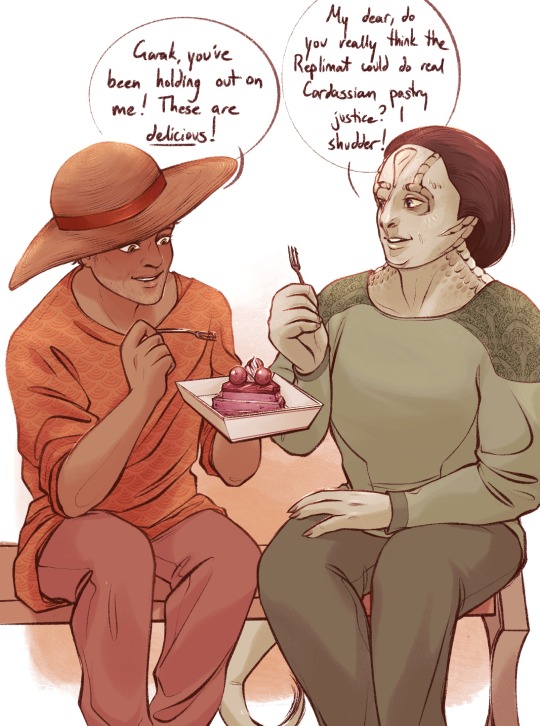
thanks to mels for pointing out that star trek disco has now established that cardassians are known for loving cake to such a degree that it's part of other species cultural lingo. truly love that for them. you know the first real sign that cardassia's postwar economic miracle is revving up is when the patisseries of lakat reopen
#dee s 9#the quote being “I have missed you like a Cardassian misses cake”#which like Has it ever been... established that... the space totalitarians love a big ol slice? i mean. i love that lore.#cardassian buddy valestro cakeboss is toiling away in the bombed out shell of his kitchen. mi familia. he is making cake 4 the state#anyways i loved exquisitely rendering that cake i put my all into it#garashir#i suppose#they are sharing a sweets date in the business district postwar#JULIANS FLOPPY STRAW HAT MAKES A COMEBACK AAAAAAYYYY#i went to like 3 fine bakeries this weekend so St Honores on the brain ig
474 notes
·
View notes
Text
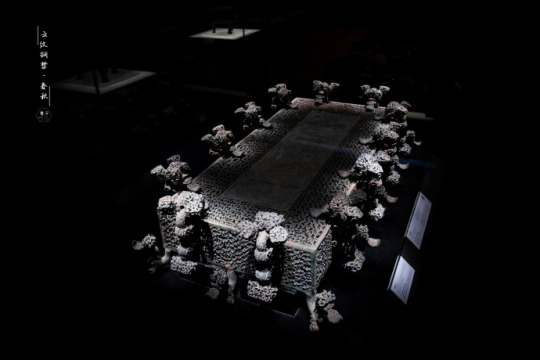

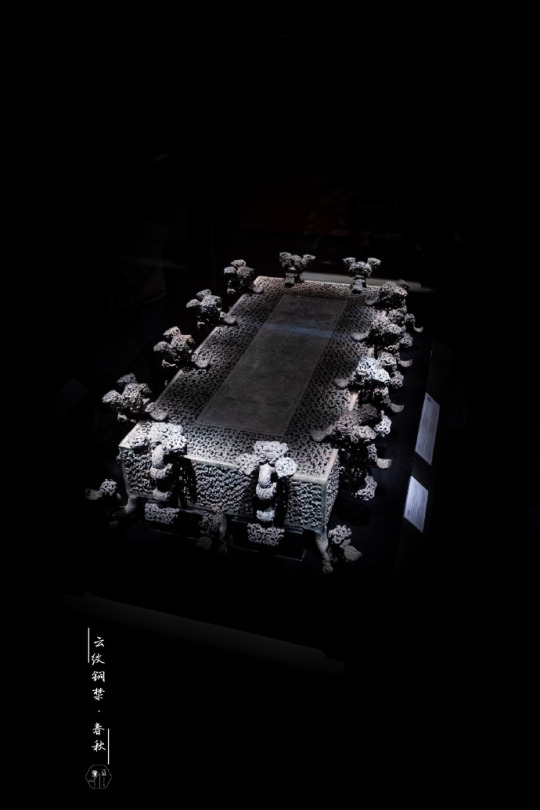



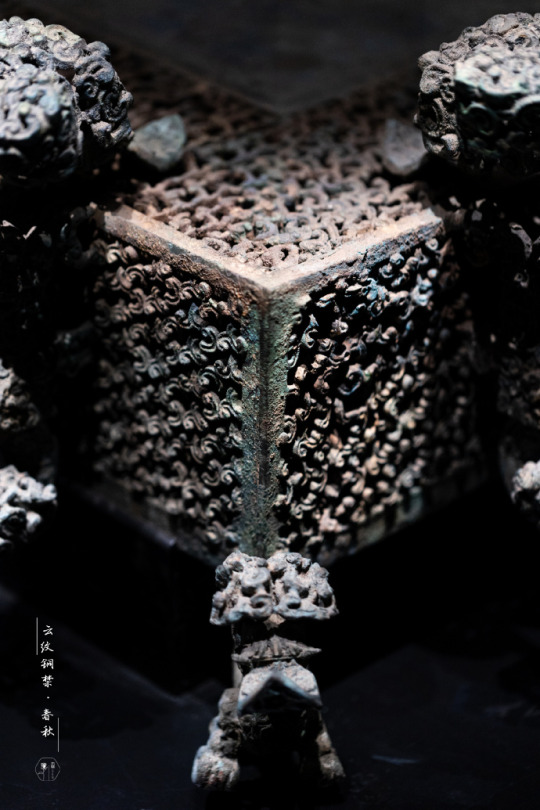

Cloudy Wine Table of The Spring and Autumn Period
Another attribute of the antique bar: a bronze wine table Jin (禁).
The name of this piece of furniture involves social advertising. Jin means “forbidden”. The name is aimed at potential consumers, encouraging them to be moderate in drinking.
It was believed that the Shang and Xia dynasties fell into decline due to alcohol abuse. The term itself has been in use since the Zhou Dynasty, when the first Dry Law was proclaimed. Wine was allowed only in rituals, in other cases, drinking it entailed the death penalty. For the same reason, it could be assumed that the table also had a religious purpose.
The wine table belonged to the Grand Chancellor Zi Geng during the reign of King Kang of Chu (楚康王).
It was manufactured with a lost-wax casting, a technology that is more often used in jewelry. The wine table rests on twelve dragons that serve as its legs. Twelve more surround it, trying to climb onto the tabletop from all sides.
Sophisticated clouds are not just for decoration. It is an allegory of the primordial forces, accumulated between Heaven and Earth, in action. The very pictograph for Qi, invented just in the Spring and Autumn period, refers to the clouds.
Finely crafted, the table was unearthed in fragments. It was a feat on the part of the restorers to bring it together. Rebuilding under the guidance of the bronze ware expert Wang Changqing took more than two years.
On display in Henan Museum (河南博物院).
#ancient china#chinese culture#chinese art#chinese history#table#table styling#wine table#bronze design#bronze art#bronze#zhou dynasty#Spring and Autumn period#State of Chu#House of Mi#pattern
36 notes
·
View notes
Text

A glorious Midwestern fall day...
Photo: Thompsonville, Michigan
#michigan#nature#fall colors#fall foliage#fall leaves#autumn#autumn vibes#autumn colors#autumn foliage#midwest#mi#the mitten#lower peninsula#the wolverine state#midwestern fall#road trip#travel#tourism#adventure#explore#the great lakes state#great lakes#traverse city
72 notes
·
View notes
Text

La natura sta sguarendo and I'm channeling the frantic pacing into drawing
#[.art]#listen. I don't dabble in fandom all that much aside from posting art and discussions with the same three people#so I don't know the state of the les mis fandom. I don't know you freaks (neutral) I don't know what you get up to. I've been told it's mad#but I do want to organise my blog so this is getting maintagged#les misérables#javert#second disclaimer is I also don't know what the... standard interpretation for this guy is. I just searched how he's described in the book#as that seemed like the most reasonable source? I do know one (1) person in the actual fandom. kind of. but I am not asking#my point is I like javert
147 notes
·
View notes
Text

#fregare#preferito#tenerezza#frasi#amore#frasi belle#frasi d'amore#ti amo#amore a distanza#love#i love you#frasi tristi#innamorata#insieme#state insieme#inseparabili#vicini#vicino#vicinanza#innamorati#innamorato#innamorarsi#innamorata di te#mi sono innamorata#rimanere#rimani#restare#resta#andare via#coppia
26 notes
·
View notes
Text

i'll settle for the ghost of you
(do not repost w/ out permission)
reblogs >>> likes
#banged this out this morning in a fugue state#my art tag#op#op fanart#one piece#one piece fanart#asl one piece#asl brothers#asl trio#revolutionary sabo#portagas d. ace#portgas d ace#creation of adam#mera mera no mi#op spoilers#asl#sabo#ace
59 notes
·
View notes
Photo
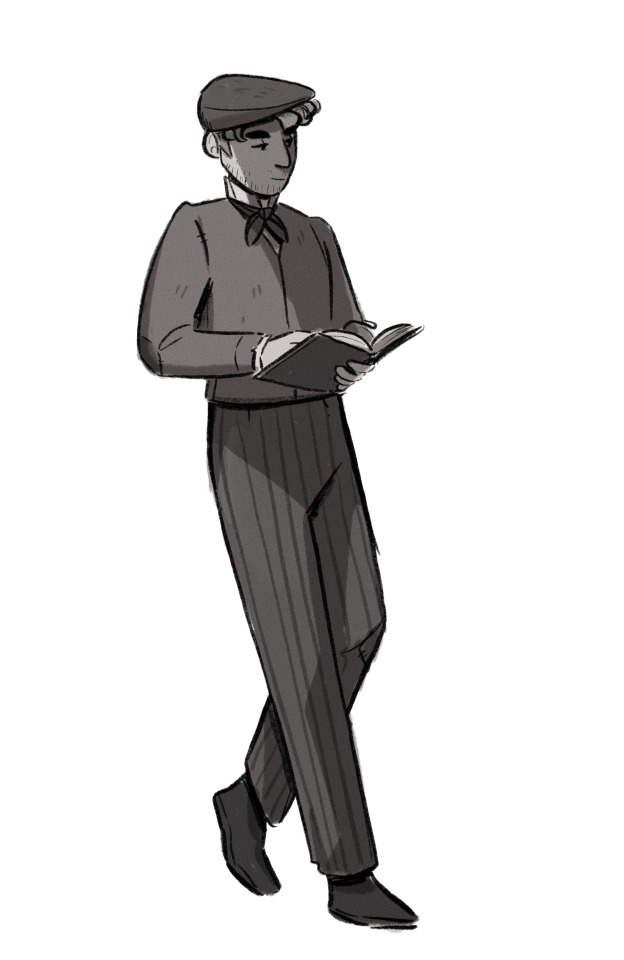
Feuilly with a book for @thepiecesofcait. Thank you!
#Hello mr feuilly it’s been a while#ko-fi requests#feuilly#les mis#so he was supposed to be reading under a street lamp or something like that#and I refused to look up the state of public lights in Paris in the 1830s so uuuh don’t worry about it man
236 notes
·
View notes
Text
Mi state dicendo che voi non siete così x
#quella sulla scenografia del tg1#SULLE PUBBLICITÀ#ma io sono così non ironicamente ma che mi state dicendo#ho passato tutto ottobre a farmi i cazzi miei durante affari tuoi e guardare solo le pubblicità#per i promo#sanremo
24 notes
·
View notes
Text
blows my mind reading fanfic in the les mis fandom of all places - les amis fanfic too - and seeing that overall there's more neutral-positive attitude towards cops than there ever is towards sex workers.
fucking. cops.
like i know u guys hate us (sex workers) that's very apparent, i know, but really? the fics about the little guys trying to change the world fighting against the system in place and were fully killed by the national guard will have bangers like "the police are just doing their job". fr?
and those same fics will have enjolras campaigning for sex workers to not be able to safely do their jobs. ok.
anyway writers who have enjolras as a staunch sex worker ally who listens to actual sex worker community organisers and supports them in fighting for full decriminalisation i am holding you tenderly in my hands and kissing you top of head.
writers who understand the gravity of what they're writing about re: police and understand the very simple fact that ACAB and have some real direct action fuck the state anarchist/domestic terrorist enjolras & abc, i'm shielding you from everything bad in this world and blessing ur first born.
and swerf bootlickers i hope you run face first into a hammer <3
#bothers me bc again none of this is in a vacuum#bet the people writing these fics are the people we're battling against when trying for full decriminalisation#did you know i live in one of the ... i think it's three total locations in the entire world where sex work is even partially decriminalised#and that's not the whole country#just the state#like it's a long fucking road ahead and public opinion is the number one challange and this is a way it manifests#anyway yeah yeah hooker rage i know no one cares but listen: acab#hooker posting#sex work in les mis#tagging it that just bc .. u know... wider fanfom
21 notes
·
View notes
Video
#107th Fighter Squadron#A-10C Thunderbolt II#127th Wing#Selfridge Air National Guard Base#Michigan Air National Guard#Selfridge Air National Guard Bas#Michigan#United States#MI#MING#127th#Wing#all-weather#training#sortie#routine#mission#adverse#conditions#national guard#NG#national#guard#guardsman#guardsmen#soldier#soldiers#airmen#airman#u.s.
22 notes
·
View notes
Text
I’m rereading Les mis again, and one thing I didn’t notice on my first reads is just how Militarized every single town is? Even in scenes where characters are just going about their ordinary day there are always soldiers in the street, and everyone’s always mentioning prison, and the police are always there, and there are always traces of the recent wars all around—
No matter what the characters are doing, the threat of state violence is always There. The threat of the military and police and government is always hanging over them.
Like in Fantine’s chapters with Tholomyes! As the four couples are going on their dates, there are constant references to how “Everything is Fine Now Because the Monarchy has Finally Put Down those Nasty Rebels and is Back in Power Again.”As the couples flirt and play, there are gendarmes in the street and people singing rowdy songs about the return of the king. There’s an entire intro chapter about the year’s historical context, and the rest of the chapters contains sprinkles of anecdotes about the new regime.
Hugo draws what I feel is a pretty explicit parallel between Tholomyes and the new King. We’re told that is fine in Paris because King Louis is on the throne: and we’re told that everything is idyllic in Fantine’s friend group because Tholomyes is its (quote) “dictator” who leads in a way that obligates everyone to obey.
Of course in the end Everything is Not Fine and these dictators can’t actually be trusted to rule over their people, and are going to especially hurt marginalized people like Fantine.
But it’s not just this one subplot obviously, it’s Every Single One. The threat of military violence is the background noise of the entire book.
Montreuil-sur-Mer where Valjean becomes mayor is literally a garrrison town for the military; Paris is always swarming with police and gendarmes; Marius’s story centers on his changing feelings about his Bonapartist soldier father; the Thenardiers live at the Waterloo Inn and constantly go on about Monsieur Thenardier’s military history; like the threat of the military/police is always there in the background of every scene, long before it comes to a head at the barricade.
One of the subplots that illustrates this best is Everything that Happens In Digne after Valjean is released from prison.
Valjean shows his yellow passport to the mayor and is immediately followed by a gendarme before he heads to an inn. His passport causes every inn to refuse service to him. After he asks a kind-looking peasant man at home with his family if he can stay at his house for the night, the man pulls out a gun and threatens to murder him. He attempts to get temporary housing at a prison, which refuses him.
We’re later given an explanation for what the townspeople think and say about their police force, and why they’re so determined to beat Valjean away. We’re told that the townspeople say:
“The police was very badly organized, moreover, because there was no love lost between the Prefect and the Mayor, who sought to injure each other by making things happen. It behooved wise people to play the part of their own police, and to guard themselves well, and care must be taken to duly close, bar and barricade their houses, and to fasten the doors well.”
Which is a terrifying philosophy that we see throughout the book? The reason everyone is so cruel to Valjean is because in a world where everything is militarized, ordinary people have decided to become unofficial cops. It’s like they believe the problem with their society is that there aren’t enough police/soldiers on the street—even though we see police and soldiers on Every Page.
There’s something terrifyingly familiar about the mentality that looks at cities swarming with police and says “the way to fix this is to Add More Police. Or for regular citizens to Do Police Work themselves!”
And I feel like that tension, that constant pervasive threat of government violence that never goes away because ordinary people are actively supporting these institutions too, is such a tragically relevant part of the book.
#les miserables#Les mis#jean valjean#but yeah I’m like . sad about Valjean again#like is he paranoid about being found out?#yes#but look at the society he lives in!#look at all the soldiers and weapons on the street#and all the cops#and all the people making themselves Unofficial Cops#it makes sense that he lives in a state of constant terror#:(#my poor buddy John McJohn
481 notes
·
View notes
Text


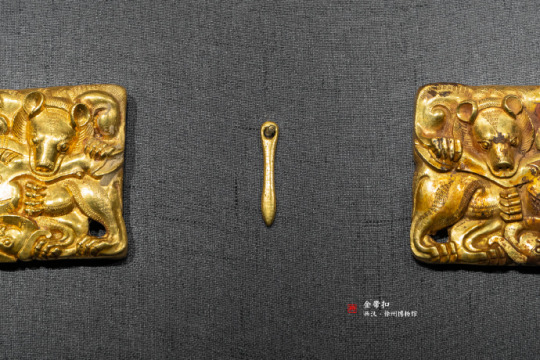



Everybody Eats Someone: Western Han Biting Artifact
Gold belt buckle of Western Han dynasty. Unearthed from the tomb of King of Chu of on Lion Rock (獅子山), Xuzhou (徐州), Jiangsu.
This dramatic buckle consists of two rectangular gold belt plates and a gold tongue. On the reliefs, everybody is eating someone. The heraldic bears of the Xiong (熊) clan, a prolongation of the royal House of Mi (芈), are present. The Ye (葉) family Taoist lineage I’ve examined here is from the same clan and House.
The bear totem is still pertinent for those with surnames Mi (芈), Yan (酓 or 檿), Shen (沈), Xiong (熊), Ye (葉), Xiang (項), Qu (屈).
The heraldic elements in the form of images represent rather archaic practice. They were gradually supplanted in China by the designation of belonging through the surnames’ hieroglyphs of or mottos.
On display in the Xuzhou Museum (徐州博物館).
#ancient china#chinese culture#chinese art#western han dynasty#han dynasty#antique jewelry#chinese jewelry#jewelry#jewelry design#ancient jewelry#gold#jewels#belt buckle#bear#chinese miniatures#House of Mi#State of Chu
62 notes
·
View notes
Text








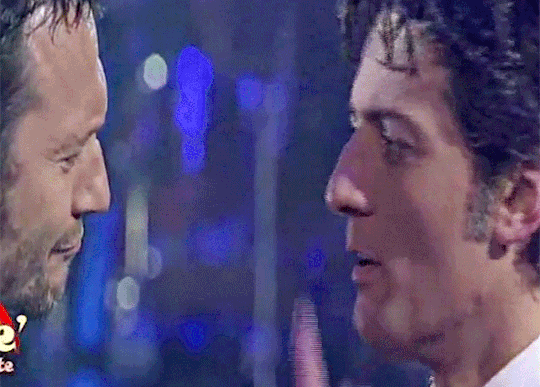




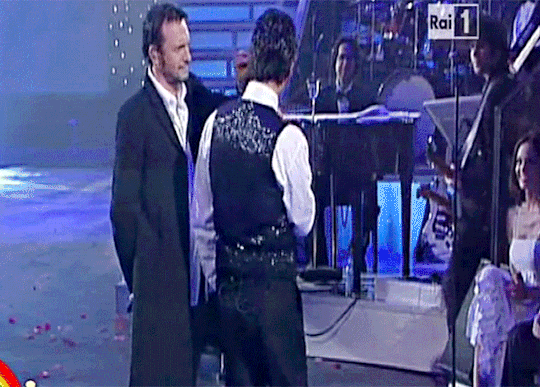


Fiorello e Biagio Antonacci, circa 2002, courtesy of Techetechetè (x)
Questo gifset mi piace chiamarlo "he literally didn't have to do All That"
#mi disp per la shitty quality ma anche in qualità infima questa cosa andava documentata#remember to always get really close and personal to your homies and look at their lips like a harlot on national tv#fiorello#biagio antonacci#ma comunque davvero honey? antonacci?#well whatever makes my princess happy#i think he might have a type actually.......#ho messo momentaneamente da parte un amarello gifset per fare questo che purtroppo mi ha mandato in un fugue state da quando l'ho visto#scusate amarello nation#mine#stasera pago io
8 notes
·
View notes
Text

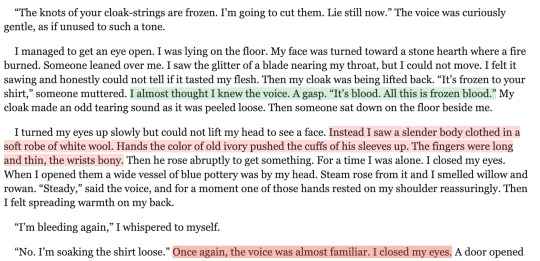


#he really found him in the forest when he was about to die omg#and not only is the fool appalled at his current state he'll also crack a joke as he gently tends to his wounds#mi pana Fitz el colador...#don't get me started on fitz' descriptions here i won't even touch that#rote
16 notes
·
View notes
Text
packing up my bindle and trudging back to the classic lit fandom 💔
#anyway i started reading dogra magra and it's. certainly something#also reading hermann hesse's the prodigy (beneath the wheel)#now THIS is dark academia. except the dark academia girlies would never accept it for how it criticises the education system.#and also because the dark academia girlies have completely warped the original concept of dark academia books </3#i should also continue les mis. i'm such a fake fan i haven't even finished volume 1#same with moby dick. i paused it about 1/3 of the way in. but luckily there's no plot so i can just pick it up again whenever#aough i just remembered i'm also partway through little women. and 1/3 of the way through my reread of frankenstein#i wouldn't have this problem if i didn't spend half of my time posting about bsd on tumblr </3#NAUR THERE'S MORE. also 1/3 through vasily grossman's life and fate#and i haven't even finished my reread of crime and punishment#the state of things............ watch me forget even more books i'm so-called 'reading'#EDIT: THE SECOND HALF OF GONCHAROV'S ОБРЫВ THAT I HAVEN'T FINISHED
25 notes
·
View notes